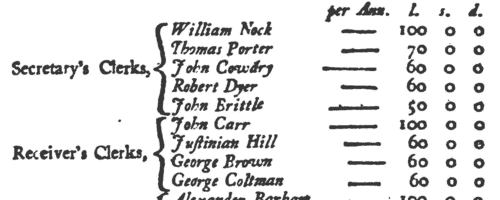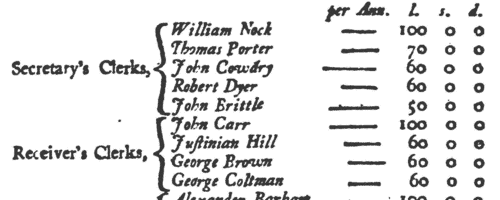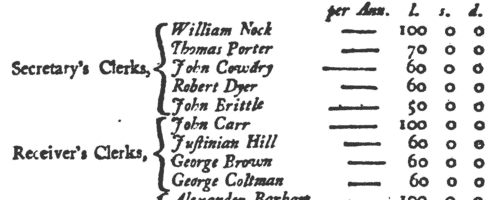Add this eBook to your basket to receive access to all 302 records. Our indexes include entries for the spelling spinks. In the period you have requested, we have the following 302 records (displaying 1 to 10): These sample scans are from the original record. You will get scans of the full pages or articles where the surname you searched for has been found. Your web browser may prevent the sample windows from opening; in this case please change your browser settings to allow pop-up windows from this site.  Masters and Apprentices
(1715) Masters and Apprentices
(1715)
Apprenticeship indentures and clerks' articles were subject to a 6d or 12d per pound stamp duty: the registers of the payments usually give the master's trade, address, and occupation, and the apprentice's father's name and address, as well as details of the date and length of the apprenticeship. 2 May to 31 December 1715. | Sample scan, click to enlarge

| Treasury and Customs Officials, Officers and Pensioners
(1717)
Government accounts, with details of income and expenditure in Britain, America and the colonies
| Sample scan, click to enlarge

|  Masters and Apprentices
(1719) Masters and Apprentices
(1719)
Apprenticeship indentures and clerks' articles were subject to a 6d or 12d per pound stamp duty: the registers of the payments usually give the master's trade, address, and occupation, and the apprentice's father's name and address, as well as details of the date and length of the apprenticeship. 22 June to 31 December 1719. | Sample scan, click to enlarge

|  Masters of Apprentices registered at Devizes in Wiltshire
(1723-1726) Masters of Apprentices registered at Devizes in Wiltshire
(1723-1726)
Apprenticeship indentures and clerks' articles were subject to a 6d or 12d per pound stamp duty: the registers of the payments usually give the master's trade, address, and occupation, and the apprentice's father's name and address, as well as details of the date and length of the apprenticeship. There are central registers for collections of the stamp duty in London, as well as returns from collectors in the provinces. These collectors generally received duty just from their own county, but sometimes from further afield. Because of the delay before some collectors made their returns, this register includes indentures and articles from as early as 1722. (The sample entry shown on this scan is taken from a Norfolk return) | Sample scan, click to enlarge

|  Apprentices registered in Norfolk
(1728-1731) Apprentices registered in Norfolk
(1728-1731)
Apprenticeship indentures and clerks' articles were subject to a 6d or 12d per pound stamp duty: the registers of the payments usually give the master's trade, address, and occupation, and the apprentice's father's name and address, as well as details of the date and length of the apprenticeship. There are central registers for collections of the stamp duty in London, as well as returns from collectors in the provinces. These collectors generally received duty just from their own county, but sometimes from further afield. (The sample entry shown on this scan is taken from a Norfolk return) | Sample scan, click to enlarge

| Custom House Officials
(1741)
'A General List, or Catalogue, Of all the Offices and Officers Employ'd In the several Branches of his Majesty's Government Ecclesiastical, Civil, Military, &c. In South-Britain, or England' gives the names (and often the annual salaries) of the government functionaries, civil servants, churchmen and military, systematically arranged section by section. Section 25(a) lists the commissioners, officers and others belonging to the Custom House, including the customs officers of the Port of London, at the out-ports of Sandwich, Chichester, Southampton, Poole, Plymouth, Exeter, Gloucester, Bristol, Bridgwater, Cardiff and Swansea, Milford, Ipswich, Yarmouth, Lynn, Boston, Hull, Newcastle, Berwick, Carlisle and Chester; and officers appointed by the commissioners at Rochester, Faversham, Sandwich, Deal, Dover, Rye, Shoreham, Arundel, Newhaven, Chichester, Portsmouth, Southampton, Poole, Cowes, Weymouth, Lyme, Exeter, Dartmouth, Plymouth, Looe, Fowey, Falmouth, Penryn, Truro, Penzance, St Ives, Padstow, Biddeford, Barnstaple, Ilfracombe, Minehead, Bridgwater, Bristol, Gloucester, Chepstow, Cardiff, Swansea, Milford, Llanelly, Cardigan, Aberdovey, Maldon, Colchester, Harwich, Woodbridge, Aldeburgh, Southwold, Ipswich, Yarmouth, Blakeney and Cley, Wells, Lynn, Wisbech, Boston, Hull, Bridlington, Scarborough, Whitby, Stockton, Sunderland, Newcastle, Berwick, Carlisle, Whitehaven, Lancaster, Preston and Poulton, Liverpool, Chester and Beaumaris; and in the Plantations at Carolina and the Bahamas, South Carolina, North Carolina, Roanoake, Brunswick, Virginia, Maryland, Pennsylvania, East Jersey, New York, Connecticut, New England, Bahamas, and Barbados. | Sample scan, click to enlarge

| Excise Commission
(1741)
'A General List, or Catalogue, Of all the Offices and Officers Employ'd In the several Branches of his Majesty's Government Ecclesiastical, Civil, Military, &c. In South-Britain, or England' gives the names (and often the annual salaries) of the government functionaries, civil servants, churchmen and military, systematically arranged section by section. Section 28 lists the commissioners of his Majesty's Revenue of Excise and other officers employed in the said revenues, with separate sections for the excise officers dealing with malt and hops; hides, plate, coffee, tea and chocolate; and distillery. | Sample scan, click to enlarge

| Salt Duty Commission
(1741)
'A General List, or Catalogue, Of all the Offices and Officers Employ'd In the several Branches of his Majesty's Government Ecclesiastical, Civil, Military, &c. In South-Britain, or England' gives the names (and often the annual salaries) of the government functionaries, civil servants, churchmen and military, systematically arranged section by section. Section 29 lists the commissioners and other officers for the duty on salt for the establishment in London. | Sample scan, click to enlarge

|  Apprentices registered at Norwich in Norfolk
(1741-1745) Apprentices registered at Norwich in Norfolk
(1741-1745)
Apprenticeship indentures and clerks' articles were subject to a 6d or 12d per pound stamp duty: the registers of the payments usually give the master's trade, address, and occupation, and the apprentice's father's name and address, as well as details of the date and length of the apprenticeship. There are central registers for collections of the stamp duty in London, as well as returns from collectors in the provinces. These collectors generally received duty just from their own county, but sometimes from further afield. (The sample entry shown on this scan is taken from a Norfolk return) | Sample scan, click to enlarge

|  Masters of Apprentices registered at King's Lynn in Norfolk
(1741-1745) Masters of Apprentices registered at King's Lynn in Norfolk
(1741-1745)
Apprenticeship indentures and clerks' articles were subject to a 6d or 12d per pound stamp duty: the registers of the payments usually give the master's trade, address, and occupation, and the apprentice's father's name and address, as well as details of the date and length of the apprenticeship. There are central registers for collections of the stamp duty in London, as well as returns from collectors in the provinces. These collectors generally received duty just from their own county, but sometimes from further afield. (The sample entry shown on this scan is taken from a Norfolk return) | Sample scan, click to enlarge

|
Research your ancestry, family history, genealogy and one-name study by direct access to original records and archives indexed by surname.
|












